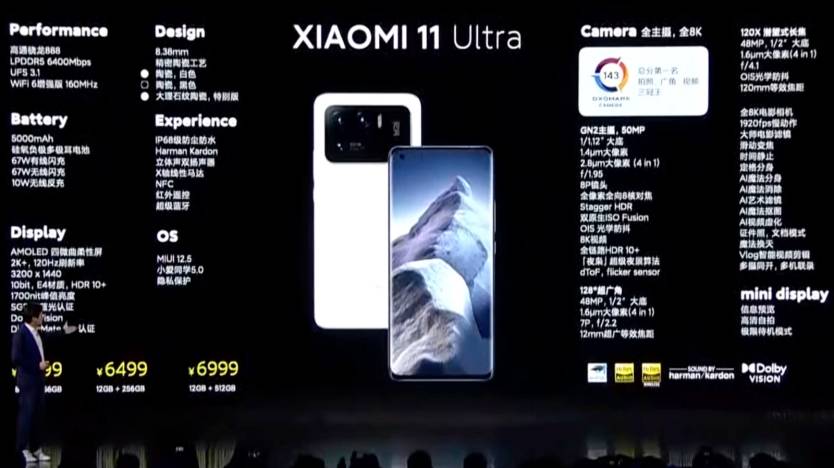Just like “Pro” or “Max,” “Ultra” branding in a smartphone name is meant to convey the message that we’re getting the best of the best. The iPhone 12 Pro Max is the best iPhone to buy right now — it has both Pro and Max in the name. The OnePlus 9 Pro is the beefiest OnePlus flagship. The Galaxy S21 Ultra is the best of the three Galaxy S21 versions launched in early 2021, and the direct successor of last year’s Galaxy S20 Ultra. But March 29th marks the arrival of a new Ultra phone, a device that’s even crazier than Samsung’s top handset — and yet it’s somehow still cheaper than the S21 Ultra.
The price detail should be enough to tell you that only a Chinese smartphone maker could undercut the Galaxy S21 Ultra’s price. Android fans who follow industry rumors probably have a pretty good idea of what phone we might be talking about. After all, the Xiaomi Mi 11 Ultra leaked several weeks ago when a YouTuber unveiled it to the world by mistake.
Xiaomi finally unveiled the Mi 11 Ultra on Monday during a press event that featured a room full of people. That’s a sight we haven’t seen in more than a year, in light of the ongoing coronavirus pandemic. The Mi 11 Ultra is part of the Mi 11 series that Xiaomi announced in December. That phone was the world’s first Snapdragon 888-powered handset, being unveiled before the Galaxy S21 series.
The Chinese smartphone giant announced additional Mi 11 series models during the event, including the Mi 11 Lite, the Mi 11 Pro, and the Mi 11 Ultra. With its dual-screen design and high-end camera system, the Ultra is the kind of flagship phone most people will want to buy, assuming it’s available in your market. And considering that Xiaomi has been rapidly gobbling up Huawei’s market share over the past few years, it’s likely the Mi 11 phones will reach many international markets, except for the US.
The Mi 11 Ultra’s main screen is a 6.81-inch quad-curved hole-punch display featuring an in-display fingerprint sensor and Corning Gorilla Victus glass. The screen delivers a 5,000,000:1 contrast ratio, 3,200 x 1440 resolution, and 120Hz refresh rate. The “mini” screen on the back is much smaller at 1.1 inches diagonally. It’s also AMOLED and has two main purposes: It shows notifications, and it lets you use the main camera module for selfies.
The rear camera is the Mi 11 Ultra’s main selling point. The company made a big deal of the camera, comparing it with a regular Sony camera and touting a record-breaking DxOMark score. Of note, DxOMark scores still don’t actually mean anything.

The camera specs are impressive nonetheless. The primary camera has a 50-megapixel 1/1.12’’ sensor and supports optical image stabilization (OIS) and dToF laser focus. The 48-megapixel camera has a 128-degree field of view handy for those selfies and supports macro shooting. The 48-megapixel OIS telephoto lens does 5x optical zoom, 10x hybrid zoom, and 120x digital zoom — the latter is just as gimmicky as Samsung’s 100x digital zoom. All three cameras can record 8K video. The front-facing camera has a 29-megapixel sensor.
The battery is another highlight of Xiaomi’s new Ultra phone. We’re looking at a 5,000 mAh battery capacity that needs just 36 minutes to reach a full charge at 67W speeds. The speed is the same regardless of whether you use wired charging or Xiaomi’s special wireless charger, a feature that’s not available on other handsets.
The rest of the specs list screams flagship. We have the 5G-ready Snapdragon 888 platform, 8/12 GB of LPDDR6 RAM, 256/512GB of UFS storage, Wi-Fi 6, and Bluetooth 5.2 connectivity. Prices start at 5,999 yuan ($913) for the Mi 11 Ultra with 8GB of memory and 256 of storage and go to 6,999 yuan ($1,065) for the 12GB/512GB model. The Galaxy S21 Ultra was priced at $1,199.99 and up when it debuted in mid-January.
Xiaomi’s full press event can be replayed below. Besides the Mi 11 Ultra, you’ll also see the Mi 11i (a European Mi 11 version), Mi 11 Lite, and Mi 11 Pro. Xiaomi also launched a new Mi Smart Band 6 wearable, an AirPower-like universal wireless charger, and a new Mi Smart Projector 2 Pro device.







